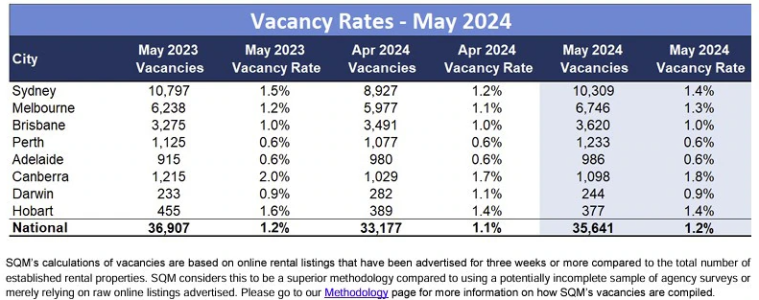Relief for renters: Australia records biggest rent decline in 4 years, research says
Rent is often the largest expense for many households, consuming a substantial portion of their income. For families and individuals alike, the high cost of housing can be a major financial strain, affecting everything from savings potential to overall quality of life.
In a turn of events that has caught many by surprise, Australian renters have been given a glimmer of hope as advertised rents across the nation's capital cities have seen the most significant monthly drop in four years.
According to the latest figures from SQM Research, the average rent in the capitals decreased to $723 last month, which represents a 0.5 percent decline over the past 30 days.
This is the most substantial monthly fall since April 2020, when the world was just beginning to grapple with the uncertainties of the COVID-19 pandemic.
The decrease in rental prices comes alongside forecasts that vacancy rates are expected to increase over the winter months.
However, Louis Christopher, the Managing Director of SQM Research, cautioned that this does not signal the end of the rental crisis.
He stated: ‘The full year outlook remains the same in that we expect overall tight vacancy rates to be with us for 2024, driven by a fall in dwelling completions relative to ongoing growing demand.’
‘Nevertheless, it might provide some minor relief to tenants who still have excessive difficulties in finding longer-term rental accommodation around the country,’ he added.
Delving into the specifics, Sydney's advertised rents have been a significant contributor to the overall decline, with a 1.1 per cent drop to $844 a week.
Darwin experienced the most considerable decrease at 6.3 per cent, bringing rents down to $566 a week.
Melbourne's rents remained stable at $635 a week, while Adelaide bucked the trend with a rapid rental rise of 2.1 per cent to $593.
The national median weekly asking rent for a dwelling now sits at $624 per week.
Sydney continues to lead with the highest weekly rent for a house at $1,050 per week, while Hobart remains the most affordable capital city for unit rents at $463 per week.

Vacancy rates in Sydney are currently at 1.4 per cent, with 10,039 rental dwellings available.
Melbourne also saw an uptick in its vacancy rate, increasing to 1.3 per cent from 1.1 per cent in April this year.
Across Australia, the total number of rental vacancies now stands at 35,641 residential properties, up from 33,177 vacancies recorded in April.
For our readers, particularly those over 60 who may be renting or assisting family members with their rental situations, this news could be a silver lining amidst the mounting cost-of-living pressures in recent years.
It's an opportune moment to reassess your rental agreements and explore the market for potentially more affordable options.
As we navigate through these changing times, it's essential to stay informed about the trends in the rental market.
Whether you're looking to move or renegotiate your current lease, understanding the dynamics at play can help you make the best financial decisions.
If you're having difficulty paying rent, there are government initiatives available to help. Rent Assistance is a supplementary payment for individuals receiving specific Centrelink payments who also have accommodation expenses such as household rent, retirement village fees, or mooring fees for boats and caravans. You can learn more about Rent Assistance here.
 We invite you to share your experiences and thoughts on this latest development in the comments below.
We invite you to share your experiences and thoughts on this latest development in the comments below.
Have you noticed a decrease in rental prices in your area? Are you considering a move to take advantage of the current market conditions? Let us know in the comments below!
In a turn of events that has caught many by surprise, Australian renters have been given a glimmer of hope as advertised rents across the nation's capital cities have seen the most significant monthly drop in four years.
According to the latest figures from SQM Research, the average rent in the capitals decreased to $723 last month, which represents a 0.5 percent decline over the past 30 days.
This is the most substantial monthly fall since April 2020, when the world was just beginning to grapple with the uncertainties of the COVID-19 pandemic.
The decrease in rental prices comes alongside forecasts that vacancy rates are expected to increase over the winter months.
However, Louis Christopher, the Managing Director of SQM Research, cautioned that this does not signal the end of the rental crisis.
He stated: ‘The full year outlook remains the same in that we expect overall tight vacancy rates to be with us for 2024, driven by a fall in dwelling completions relative to ongoing growing demand.’
‘Nevertheless, it might provide some minor relief to tenants who still have excessive difficulties in finding longer-term rental accommodation around the country,’ he added.
Delving into the specifics, Sydney's advertised rents have been a significant contributor to the overall decline, with a 1.1 per cent drop to $844 a week.
Darwin experienced the most considerable decrease at 6.3 per cent, bringing rents down to $566 a week.
Melbourne's rents remained stable at $635 a week, while Adelaide bucked the trend with a rapid rental rise of 2.1 per cent to $593.
The national median weekly asking rent for a dwelling now sits at $624 per week.
Sydney continues to lead with the highest weekly rent for a house at $1,050 per week, while Hobart remains the most affordable capital city for unit rents at $463 per week.

The calculation of vacancies by SQM is based on online rental listings advertised for three weeks or more, compared to the total number of established rental properties. Source: SQM Research
Vacancy rates in Sydney are currently at 1.4 per cent, with 10,039 rental dwellings available.
Melbourne also saw an uptick in its vacancy rate, increasing to 1.3 per cent from 1.1 per cent in April this year.
Across Australia, the total number of rental vacancies now stands at 35,641 residential properties, up from 33,177 vacancies recorded in April.
For our readers, particularly those over 60 who may be renting or assisting family members with their rental situations, this news could be a silver lining amidst the mounting cost-of-living pressures in recent years.
It's an opportune moment to reassess your rental agreements and explore the market for potentially more affordable options.
As we navigate through these changing times, it's essential to stay informed about the trends in the rental market.
Whether you're looking to move or renegotiate your current lease, understanding the dynamics at play can help you make the best financial decisions.
If you're having difficulty paying rent, there are government initiatives available to help. Rent Assistance is a supplementary payment for individuals receiving specific Centrelink payments who also have accommodation expenses such as household rent, retirement village fees, or mooring fees for boats and caravans. You can learn more about Rent Assistance here.
Key Takeaways
- Advertised rents in Australian capital cities have experienced the largest monthly drop in four years, offering some relief to renters.
- Average rents in the capitals decreased by 0.5 per cent last month, with the significant fall partly attributed to the pandemic's impact in April 2020.
- Despite the drop, experts from SQM Research suggested that the rental crisis is not over, forecasting tight vacancy rates to continue into 2024 due to lower dwelling completions and rising demand.
- Sydney and Darwin saw notable decreases in advertised rents, with Sydney recording a 1.1 per cent fall and Darwin experiencing a 6.3 per cent dip. Conversely, Adelaide's rent rose by 2.1 per cent.
Have you noticed a decrease in rental prices in your area? Are you considering a move to take advantage of the current market conditions? Let us know in the comments below!








